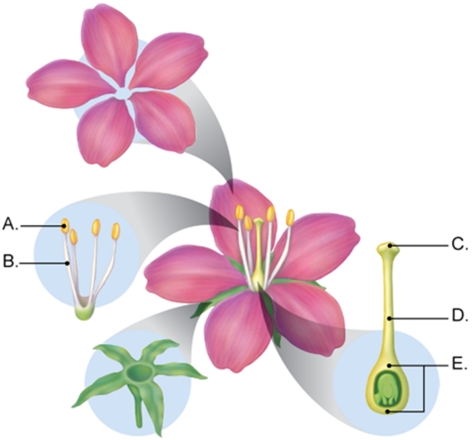A) A
B) B
C) C
D) D
E) E
Correct Answer

verified
Correct Answer
verified
Multiple Choice
Figure:  -Which structure is the ovary?
-Which structure is the ovary?
A) A
B) B
C) C
D) D
E) E
Correct Answer

verified
Correct Answer
verified
Multiple Choice
Which structures were required for the evolution of the ferns and gymnosperms?
A) seeds and flowers
B) megaphylls and seeds
C) microphylls and megaphylls
D) flowers and vascular tissue
E) megaphylls and vascular tissue
Correct Answer

verified
Correct Answer
verified
Multiple Choice
Which statement about chytrids is incorrect?
A) They have flagellated spores and gametes.
B) They are obligate parasites.
C) Some are unicellular while others form hyphae.
D) Some have an alternation of generations life cycle.
E) Some stages of their life cycle are motile.
Correct Answer

verified
Correct Answer
verified
Multiple Choice
How is a mycelium a valuable adaptation for a fungus?
A) It provides a strong anchor for the fungus.
B) It provides a large surface area for the absorption of nutrients and moisture.
C) It discourages animals from feeding on the fungus.
D) It provides a vast surface area for the generation of spores.
E) It provides physical support for the fragile sporophyte generation.
Correct Answer

verified
Correct Answer
verified
Multiple Choice
Part Z is ________. 
A) stored food
B) the sporophyte embryo
C) the seed coat
D) the gametophyte embryo
E) vascular tissue
Correct Answer

verified
Correct Answer
verified
Multiple Choice
Which structure is characteristic of angiosperms?
A) vascular tissue
B) seed
C) leaf
D) flower
E) megaphyll
Correct Answer

verified
Correct Answer
verified
Multiple Choice
Which statement about the plant alternation of generations life cycle is incorrect?
A) Spores are produced by meiosis.
B) The zygote is diploid.
C) The zygote undergoes mitosis to produce the sporophyte plant.
D) Gametes are only produced by meiosis.
E) Both gametes and spores are haploid.
Correct Answer

verified
Correct Answer
verified
Multiple Choice
The closest living relatives of land plants are
A) charophytes.
B) chytrids.
C) sporozoans.
D) cyanobacteria.
E) lichens.
Correct Answer

verified
Correct Answer
verified
Multiple Choice
In ferns, the dominant generation is the
A) haploid gametophyte.
B) diploid gametophyte.
C) haploid sporophyte.
D) diploid sporophyte.
E) triploid endosperm.
Correct Answer

verified
Correct Answer
verified
Multiple Choice
If you were to examine chunks of coal for plant fossils, you would most likely find
A) stoneworts.
B) bryophytes.
C) angiosperms.
D) conifers.
E) seedless vascular plants.
Correct Answer

verified
Correct Answer
verified
Multiple Choice
A mutualistic association between a fungus and a cyanobacteria or green algae is a
A) chytrid.
B) mushroom.
C) lichen.
D) moss.
E) mycorrhiza.
Correct Answer

verified
Correct Answer
verified
Multiple Choice
Which of these is mismatched?
A) carpel-ovary
B) stamen-anther
C) calyx-stigma
D) corolla-petal
E) stamen-filament
Correct Answer

verified
Correct Answer
verified
Multiple Choice
When making bread, you first "proof" the yeast by mixing with sugar in lukewarm water. Assuming that the yeast are alive, what happens next and why?
A) The water will become cloudy as the flagellated yeast cells swim around.
B) The yeast will germinate and start to form a mycelium.
C) Bubbles form as the yeast ferment the sugar and release carbon dioxide.
D) Bubbles form as the yeast produce sugar and release oxygen.
E) Nothing could happen, since yeast are not living organisms.
Correct Answer

verified
Correct Answer
verified
Multiple Choice
Conifers such as pine trees are
A) angiosperms.
B) lycophytes.
C) bryophytes.
D) charophytes.
E) gymnosperms.
Correct Answer

verified
Correct Answer
verified
Multiple Choice
In the fern life cycle, which of these is haploid?
A) frond only
B) zygote only
C) gametophyte only
D) gametes only
E) both gametophyte and gametes
Correct Answer

verified
Correct Answer
verified
Multiple Choice
Which of these is mismatched?
A) bryophytes-flagellated sperm
B) lycophytes-microphylls
C) ferns-megaphylls
D) gymnosperms-fruits
E) angiosperms-seeds
Correct Answer

verified
Correct Answer
verified
Multiple Choice
Which of these would you expect to thrive in areas with abundant moisture?
A) ferns only
B) mosses only
C) lycophytes only
D) mosses and ferns but not lycophytes
E) mosses, ferns, and lycophytes
Correct Answer

verified
Correct Answer
verified
Multiple Choice
A plant has vascular tissue and true roots, stems, and leaves, but it does not produce seeds. The plant has microphylls and bears its sporangia in strobili. This plant is a
A) bryophyte.
B) fern.
C) lycophyte.
D) gymnosperm.
E) angiosperm.
Correct Answer

verified
Correct Answer
verified
Multiple Choice
Which of these is mismatched?
A) ovule-seed
B) ovary-fruit
C) microspore mother cell-pollen
D) embryo-male gametophyte
E) megaspore mother cell-female gametophyte
Correct Answer

verified
Correct Answer
verified
Showing 21 - 40 of 56
Related Exams